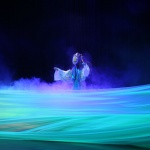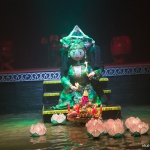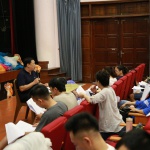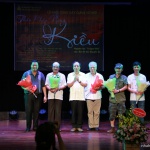Once in the past, audiences were indifferent to water puppet shows, maybe because they were only served with old plays and historical stories such as Teu, Knight fighting tiger, Thach sanh beheading python etc. When Vietnam shifted over to the market economy, water puppetry had a chance to revitalize, as put it by Mr. Vương Duy Biên – Director of the Vietnam Puppetry Theatre, water puppetry could access a new market very quickly. However, Vietnam’s water puppetry has just revitalized recently when artists knew how to move from short and extracted plays to complete plays.
The beauty of water puppets in the soul of Vietnamese countryside
Almost all countries have puppetry, but water puppetry only exists in Vietnam. Water puppetry came into existence since the Ly Dynasty. In this Dynasty, both ground puppet and water puppet were cleverly combined, very skillful and delicate in their performance. Water puppets including wooden animals, wooden statues, and disguised characters play on the stage. But what is special of it is the water environment used as their stage and their performance is in the back ground of folk singing.
In addition to inheriting the traditional techniques, today craftsmen also create and enrich this traditional art form with many different plays and items as well as performing technique and song wordings. In recent years, puppetry has had a foothold in people’s life and the country’s culture. In addition to the Vietnam National Puppetry Theatre and the Thang Long Puppetry Theatre which are interesting addresses for viewers, there are some well-known local water puppet troupes such as Đào Thục, Tế Tiêu, Tràng Sơn, Bình Phú, Thạch Xá, Nguyên Xá and Nam Chấn, which contribute to enriching the spiritual life of domestic and foreign audiences.
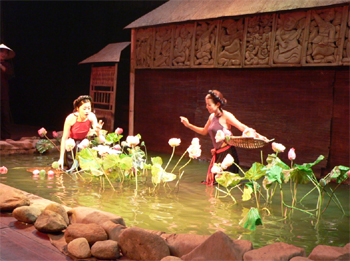
Country’s Soul – a play combined water puppetry and the installation art - of the Vietnam National Puppetry Theatre has breathed a new life to Vietnam’s water puppetry
In particular, most typical among them is the Thẩm Rộc puppetry of the Tay ethnic minority group in Định Hoá district, Thai Nguyen Province. For 13 generations now, puppetry has been conserved by the Ma Quang family. Although going through ups and downs, this traditional craft has still been handed down until today. Thẩm Rộc puppetry is a form of stick puppet, often comprising 12 members including puppeteers, musicians and assistants. The way of maneuvering puppets of the Thẩm Rộc puppet troupe is somehow different to other puppet groups. In addition to some puppets pulled with strings and handled by hand, most of the puppets are maneuvered by bamboo sticks.
New perspective of water puppetry
Also according to Mr. Vương Duy Biên, puppet troupes have to create new plays and new items having the breath of modern life. Recently, the Vietnam National Puppetry Theatre organized an innovation competition on contemporary topics among puppet art troupes based on such criteria. The results of this competition show the improvement in terms of “quality” of puppet art troupes and restoration of many plays based on historical stories. Thanks to this renovation, for the first time, audiences had a chance to enjoy a new, ever seen puppet shows. The puppet plays which won prizes are all about hot issues of the contemporary life such as “My Village Festival” of Thanh Hải Puppet Art Troupe from Hai Duong province which won Class A Prize and the winners of Class B Prize were “Mother’s Lullaby” of Nghĩa Trung Puppet Art Troupe from Nam Dinh province and “Intensive Farming” of Chàng Sơn Puppet Art Troupe from Ha Tay... In particular, in the middle of March 2007, the Vietnam National Puppetry Theatre made public the water puppet play “Country’s Soul” by Director Vương Duy Bien. The audience do not only watch traditional puppet show items such as Ploughing, Buffalo Fighting, Flag Planting, Boat Racing, Bellows Pulling, Blacksmith’s... but also enjoy a “treat” of the combination of sounds, lighting and installation arts. The stage is arranged in a rather strange way: not only with a water pavilion for water puppet shows but surrounding it is a space full of the atmosphere of Vietnamese countryside with rice mortars, bamboo baskets, sieves, and screeners. This is a typical space for water puppet shows – the art that came into existence from the wet rice culture. The content of the play “Country’s Soul” targets a simple goal that is to reminisce about the native land, thus making the audiences to revisit ancient rural villages in northern Vietnam. This is a major change in terms of contents compared to traditional Vietnamese water puppetry (with only excerpts of old historical stories, without play with scripts).
The road for audience development for traditional water puppet shows seems not to be implemented overnight. Except two professional puppet theatres, puppet troupes from different regions including ethnic minority areas also have to “expose” their creativeness and quintessence. Some recent puppet plays have combined traditional puppet art and innovation with colourful costumes, breathing a new life to puppetry. This is a new experiment in which artists try to combine contemporary factors with traditional puppet art without making the latter “misfitted” to traditional puppetry. The success of new puppet plays in their experiment will be the voice of the gratefulness of present practitioners at present to their ancestors for preservation and development of the traditional culture of the nation.
Nguồn: http://cema.gov.vn
